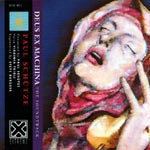deus ex machina
Extreme 1991
composed, performed and produced by Paul Schütze.
This 59 minute piece was conceived as part of a total environment for the exhibition Deus Ex Machina. The project as a whole seeks to define and articulate the emotional, cultural and aesthetic manifestations of man's uneasy relationship with technology. The music takes the form of a film score complete with stylised dialogue and actions. During the 59 minutes four basic layers repeat in various configurations. The layers comprise : 1, Directly emotive musical pieces in the style of static film scores. By static I mean that each holds a constant emotional tone with little change in colour. Each piece can be seen as a fragment of an archetypal mood. These fragments may only be defined at the points where they connect with other fragments. In the same way that it takes three points to fix a plane it takes at least three such transitions to create the impression of movement through time and so to imply narrative. 2, Both familiar and artificial atmospheres - the locating components for aural narrative. Each of these is general and more or less constant. The sound of rain on concrete is an irresistible locating atmosphere. With all the will in the world you can not hear it and retain the impression of a desert or the interior of an aircraft. 3, Specific sound events (actions) - a car pass followed by the squeal of breaks must initiate complex speculation and conclusions, which in the absence of specific visual information are bounded only by the experience and attentiveness of the listener. We have no choice in these reactions as they are not voluntary. These events rely both on the atmosphere in which they are located and the music around them for explanation. The sound of ice cubes in a glass with the atmosphere of an open runway would be enigmatic. The same sounds laced within the atmosphere of a cocktail party confirm their context and may even go unnoticed because they are familiar parts of a familiar though highly complex soundscape. 4, The sound of human speech. I have chosen speech in French and Italian as these languages share inflections and phrasing familiar to speakers of English. It is a mark of our isolation in Australia that few of us understand either language. I wanted the presence of a human voice while remaining free to ascribe non-specific meaning to the words. The dialogue is more able to enter into the implication of narrative while also remaining overheardâ. One is made to feel slightly voyeuristic. Over the course of the piece most of the components appear at least twice in various relative moments of the four layers. The effect is to provide a template of narrative in which the pieces exhibited may become protagonists, situated in hypothetical scenarios which illustrate the contentions of Deus Ex Machina and the transmission of information.
produced for absolute music p/l 1989.
voice: Virginia Trioli.
assembly: Steve Burgess, Paul Schütze and Gareth Vanderhope.
engineering: Steve Burgess.
cover concept: Paul Schütze.
graphic design: Anne-Louise Falson.
